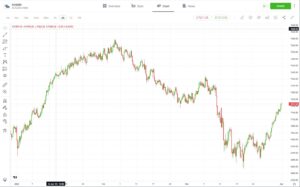The ASX200 snapped a 7-week losing streak to finish up 3.2% higher, with the materials sector doing most of the heavy lifting up 7% last week. Alongside the materials sector, every other sector on the index gained for the week. The ASX has underperformed broader global markets so far this year after outperforming last year. But for context, the ASX has outperformed the S&P500 over a two-year period, after years of underperformance.
The focus for the week ahead turns to the Reserve Bank of Australia’s rate decision, with the potential for a pause in its current hiking cycle a possibility.
3 things that happened last week:
- Australian inflation declines more than expected
Australian monthly inflation declined more than expected in February, falling to 6.8% and easing from 7.4% in January. This is an indication that inflation in Australia is falling at a faster rate than expected. Ultimately, inflation is moving in the right direction, which is the key takeaway, and it puts an end to this rate hike cycle in view. However, the fight isn’t over and there is still work to do in order to return inflation to the RBA’s target rate. We’ve seen overseas that inflation can remain stubborn. Therefore it’s too early to call this a definitive trend, and I think the RBA will want to see even clearer proof that inflation is falling before ending the current cycle.
- Alibaba looks to restructure
Alibaba (9988.HK) announced last week it would be restructuring and splitting the business into six separate groups, or companies. The intended outcome is to unlock value for each group as they pursue funding and public offerings while boosting each business’ focus. It is a classic self-help response to challenging markets and low valuations, given Alibaba’s share price has sunk more than 40 per cent in the last five years. This strategy isn’t uncommon; we’ve previously seen thirty such spinoffs in the US, from General Electric (GE) to 3M (MMM) – and more recently, Volkswagen’s (VOW3) spin-off with Porsche (PAH3). With a low 10x price/earnings valuation and five businesses emerging from the shadow of Alibaba’s dominant Taobao Tmall unit (which generates 70 per cent of the company’s revenue), the chances of success are good. If this restructuring fulfils Alibaba’s goals, the move could lead other Chinese tech conglomerates to follow.
- A winner and loser last week from the S&P/ASX200
Liontown Resources (LTR) was by far the winner on the ASX last week, gaining more than 70% after rejecting a takeover offer of $2.50 a share from lithium giant Albemarle (ALB).
Given the ASX200 enjoyed such a strong week, there were limited losers last week, but Lake Resources fell by 7% despite broader gains across the lithium space.

3 things to watch for the week ahead:
1. RBA rate decision: Will the Reserve Bank pause?
This week sees what could arguably be the most hotly contested rate decision of the RBA’s hiking cycle. Last week’s weaker-than-expected inflation reading of 6.8% has market participants split over what the Reserve Bank will do this week, pause or raise interest rates again. Inflation is moving in the right direction, which is the key takeaway, and the board will welcome this reading. However, the inflation fight isn’t over, and there is still work to do in order to return inflation to the RBA’s target rate. Although this number, alongside the global banking concerns, will more than likely give the board a tough conversation around a pause this week, I would anticipate another hike in April before the RBA looks to pause its rate hiking cycle in May. One look overseas will show the RBA that inflation has proved to be sticky, and although we’ve seen a few months of consecutive declines, inflation isn’t a one-way street. On top of inflation, the labour market is tight, business conditions are resilient, and consumer spending is falling but still robust. So even if another hike is on the cards this week, the bottom line is that the end of this tightening cycle is very close.
2. Tesla Quarterly Deliveries: Tesla delivers record quarter, sets the tone for the year
Tesla (TSLA) shares are up more than 50% YTD, a stark turnaround from its 2022 performance, with investors optimistic over ‘unprecedented’ demand. That optimism has been met, with the electric vehicle giant delivering a record 442.9k vehicles in Q1, a 36% increase year-over-year and above Wall Street expectations for 420k. Despite a murky macro backdrop, the broad price cuts earlier in the year have paid off, with a solid delivery number and will help to quash bearish calls over demand. A ramp-up in production from Gigafactories in Berlin and Texas helped push production numbers higher, while the re-opening of China, a critical market for Tesla, helped lead to this quarterly beat. This delivery number will please investors and will more than likely boost shares in early US trade this week. The worry, though, will be over its impressive margins, which will likely be affected by these price cuts. The market expects gross profit to fall to 21%, a vast contrast to the 33% in Q1 2023, and anything below 20% would be bad news for investors. This result is a win for Tesla bulls early in 2023, but the real test comes on April 19th when Tesla hands down its first-quarter earnings.
3. Retail Investor Beat: Aussies look overseas and diversify into commodities
eToro’s Retail Investor Beat Survey, taken from a quarterly survey of 10,000 retail investors across 13 countries, 1000 of which are in Australia, indicates that after more than a year of highly turbulent markets, Australian retail investors have become better diversified. They are looking further afield for opportunities in different markets and asset classes, with less ‘home bias’. The ASX200 was one of the world’s best-performing markets last year, but this year, the local market has underperformed compared to the US or Europe. Therefore, it’s no surprise to see investors looking overseas to diversify their portfolios and tap into global investment opportunities. Commodities have been the best asset class performer for the past two years; therefore, it’s clear why investors have diversified further into the asset. On top of that, Australian investors know very well that China will be looking to Australia to restock on commodities after years of limited trade, particularly when it comes to copper and iron ore. Iron Ore is Australia’s most exported commodity and is one of just a handful of commodities in the green this year.
*All data accurate as of 03/04/2023. Data Source: Bloomberg and eToro
Disclaimer:
This communication is general information and education purposes only and should not be taken as financial product advice, a personal recommendation, or an offer of, or solicitation to buy or sell, any financial product. It has been prepared without taking your objectives, financial situation or needs into account. Any references to past performance and future indications are not, and should not be taken as, a reliable indicator of future results. eToro makes no representation and assumes no liability as to the accuracy or completeness of the content of this publication.



